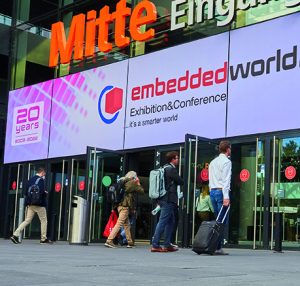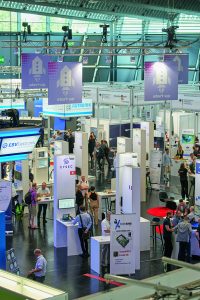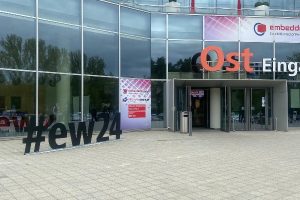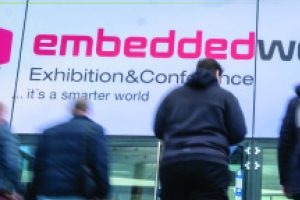One of the themes for Embedded World is connectivity – the parallel conference programme includes a keynote by Daniel Cooley, CTO, Silicon Labs Charting the Connected Future, as well as sessions around LoRaWAN, time sensitive networking, IoT management and use cases, Bluetooth and 5G.
Several of these topics are addressed by four industrial grade single pair Ethernet devices to be introduced by Microchip Technology. The LAN8650 and LAN8651 10BASE-T1S MAC-PHY Ethernet controllers with serial peripheral interface and the LAN937x and LAN938x Gb Ethernet TSN switches with integrated 100BASE-T1 phys are for connecting edge IIoT devices to the cloud. Microchip says they reduce the cost and complexity of IIoT edge devices and support high speed, Ethernet-everywhere architectures.
The LAN8650 and LAN8651 10BASE-T1S mac-phy Ethernet controllers enable the use of basic microcontrollers when creating network devices, for example, sensors and actuators. The low speed devices do not need their own communication system and are connected to a standard Ethernet system via the company’s mac-phys and use simple, twisted-pair wiring.
For the higher bandwidth of industrial applications, the LAN937x and LAN938x Gb Ethernet TSN switches have integrated 100BASE-T1 phys and include hardware time-stamping features to support TSN, including IEEE 802.1AS (gPTP) and IEEE 1588v2 (PTP). For energy efficiency, they include “ultra-deep” sleep power-down with remote wake for battery applications.
The industrial grade 100BASE-T1 devices reduce cost, wiring and installation complexity because they span from device to server, says Charles Forni, vice-president of Microchip’s USB and networking business unit. They are also designed for operation in harsh environmental conditions and across an expanded temperature range.
 Microchip will announce supporting network analysis tools and evaluation boards, the LAN8651 EVB and EVB-LAN9383. Microchip’s MPLAB Harmony 3 software includes configure, debug and program designs. The MPLAB Network Creator provides an intuitive graphical interface for switch configuration.
Microchip will announce supporting network analysis tools and evaluation boards, the LAN8651 EVB and EVB-LAN9383. Microchip’s MPLAB Harmony 3 software includes configure, debug and program designs. The MPLAB Network Creator provides an intuitive graphical interface for switch configuration.
Microchip – 3A-443
The partnership between Aries Embedded and software developer Emdalo Technologies will be highlighted at the former’s stand. The pair have jointly developed embedded modules based on Microchip’s PolarFire SoC architecture. According to Aries’ MD, Andreas Widder, the PolarFire SoC was chosen because it combines a 64-bit Risc-V multicore processor subsystem with low-power FPGA technology.
The M100PF and M100PFS system on modules (SoMs) are based on the PolarFire FPGA architecture. They are described as embedded systems for secure, power-efficient computation in smart embedded vision, industrial automation, communications and the IoT.
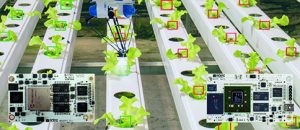 The M100PF SoM family implements the PolarFire FPGA and is available with 100K logic elements (LEs) to 300K LEs. It features 12.7G transceivers and offers up to 50% lower power than competing mid-range FPGAs, claims Aries.
The M100PF SoM family implements the PolarFire FPGA and is available with 100K logic elements (LEs) to 300K LEs. It features 12.7G transceivers and offers up to 50% lower power than competing mid-range FPGAs, claims Aries.
The M100PFS SoM integrates a hardened real-time, Linux-capable, Risc-V-based MPU subsystem on the mid-range PolarFire SoC-FPGA family, for low power consumption, thermal efficiency and defence-grade security, said the company.
Evaluation platforms for both SoMs are available.
Aries Embedded – 1-110
Following the ratification of the COM-HPC Mini module specification, congatec will present modules with 13th generation Intel Core processors (codenamed Raptor Lake) in Nuremberg. The company will showcase the Mini modules alongside its COM-HPC SoM (server on modules) down to the new, credit card-sized (95mmx60mm) COM-HPC CoM (client on modules). The latest PICMG standard is designed for applications where space is limited, such as DIN rail PCs or tablet devices. It brings a performance boost and high speed interfaces for migration without significant modification of the system design or housing, says congatec.
Visitors will also see congatec’s CoMs with 13th generation Intel Core processors on COM-HPC Client Size A and Size C. Its COM Express 3.1-compliant modules, also with 13th generation Intel Core processors, can serve as upgrade options with PCIe Gen 4 support for higher data throughput.
congatec – 3-241
Another proponent of COM-HPC modules is Adlink. It will also be demonstrating its COM Express and COM-HPC modules.
The company will introduce a discrete graphics card on the embedded MXM form factor, the MXM-AXe. It integrates the latest Intel ARC A-series graphics processor for mobile (code-named Alchemist).
There will also be an AI camera development kit for prototyping and testing edge AI vision systems. Hardware and software are installed for ease of use and there is a range of interfaces, including DI/O, COM and LAN ports, and optional accessories. The GUI-based development tool provides a low-code environment with software tools for labelling and training, and two open-source selected models so users can build a proof-of- concept model without AI expertise, says the company.
There will be a live autonomous driving proof-of-concept demonstration with a car that combines camera-lidar fusion, the RQS-59G ROS2-enabled embedded robotic controller and the AVA-3510 AI-enabled in-vehicle autonomous driving computer. It meets autonomous driving applications from levels 1 to 4, says Adlink. The company will demonstrate its customisation services for production-grade autonomous driving with an integrated liquid cooling system.
Adlink – 3-147
Distributor Arrow Electronics is using this year’s show to demonstrate its support for innovative embedded designs. Its stand will have areas dedicated to core technologies for system design and deployment and there will be presentations on trends in semiconductors, interconnect, passives and electromechanical components. There will be presentations on topics such as renewable energy, electrification of everything and AIoT.
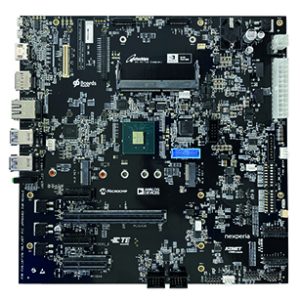 There will also be the JetCarrier96 reference design, which will be generally available from mid-March. The 96Boards enterprise edition-compliant carrier board for the Nvidia Jetson family of SoMs uses a standard microATX form factor and works with power supplies, chassis and desktop computer peripherals that are commonly available so prototyping is not delayed by sourcing. The board is designed with card slots and connectors to support peripherals and sensors and is intended to accelerate the design of custom carrier boards for autonomous machines, intelligent vision, diagnostic healthcare imaging and AIoT.
There will also be the JetCarrier96 reference design, which will be generally available from mid-March. The 96Boards enterprise edition-compliant carrier board for the Nvidia Jetson family of SoMs uses a standard microATX form factor and works with power supplies, chassis and desktop computer peripherals that are commonly available so prototyping is not delayed by sourcing. The board is designed with card slots and connectors to support peripherals and sensors and is intended to accelerate the design of custom carrier boards for autonomous machines, intelligent vision, diagnostic healthcare imaging and AIoT.
Arrow – 3A-135
Test & measurement
A number of industry firsts are claimed for the MXO 4 series oscilloscopes by Rohde & Schwarz. They are equipped with a 13.3in full HD capacitive touchscreen and are believed to offer the fastest real-time update rate at more than 4.5m acquisitions per second. They have a 12-bit ADC, which is claimed to have 16 times the resolution of traditional 8-bit oscilloscopes at all sample rates and with no trade-offs for more precise measurements, says the company. Standard acquisition memory is 400Mpoints on all four channels, which provides 100 times the standard memory of comparable oscilloscopes.
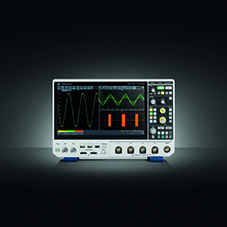 The R&S MXO 4 oscilloscopes are available in 200MHz, 350MHz, 500MHz, 1GHz, and 1.5GHz bandwidths models.
The R&S MXO 4 oscilloscopes are available in 200MHz, 350MHz, 500MHz, 1GHz, and 1.5GHz bandwidths models.
Rohde & Schwarz – 4-218
Power management
Embedded World will be the European launchpad for Qorvo’s entry into the battery management system sector. The company will introduce the first two devices in its Power Application Controller (PAC) range, the PAC22140 and PAC25140. Both have the same analogue blocks, but different processing power, memory and communication and interface options. The controllers are intended for use in high power, that is, 10 to 20 cells in a string up to 100V, for example, large power tools and garden machinery.
The company will pre-announce a 5mΩ fet TOLL, which will be officially launched at APEC in Florida, US, the following week. The 750V, 5.4mΩ (at 25°C) SiC fet is in an industry-standard TO-leadless (TOLL) package. It is claimed to have the lowest RDS(on) fet available in a TOLL package of all power semiconductors (Si, SiC and GaN) and 75% lower RDS(on) than its nearest 600/650V-class competition fet in a TOLL package.
Qorvo – 4-578
The IoT
Wireless SoCs and demos of Bluetooth, Amazon Sidewalk, Matter over Wi-Fi, Matter over ZigBee/Thread and AI/Ml will attract attention on the Silicon Labs stand.
The company’s most recent introduction, the FG25 Sub-GHz SoC for long-range deployments, will be highlighted. This SoC is suitable for long-range, low power transmission, broadcasting up to 3km with minimal data loss in dense, urban canyon environments when coupled with the EFF01 front end module, says the company.
 It is the first SoC in its portfolio to support the orthogonal frequency-division multiplexing modulations introduced in Wi-SUN Field Area Network (FAN) 1.1. Support for high data bandwidth of up to 3.6Mbps enable it to be used in large, smart city, networks. The FG25 has been certified by the Wi-SUN Alliance for the phy layer of the FAN 1.1 profile.
It is the first SoC in its portfolio to support the orthogonal frequency-division multiplexing modulations introduced in Wi-SUN Field Area Network (FAN) 1.1. Support for high data bandwidth of up to 3.6Mbps enable it to be used in large, smart city, networks. The FG25 has been certified by the Wi-SUN Alliance for the phy layer of the FAN 1.1 profile.
Silicon Labs – 4A-128/4A-129
A Risc-V SBC will be announced by Asus IoT. The Tinker V is based on a 64-bit Risc-V processor and supports both Linux Debian and Yocto for industrial IoT connectivity. It is a compact Pico-ITX form factor for IoT and gateway applications.
Asus IoT collaborated with both Renesas and Andes Technology for the SBC. It has a Renesas RZ/Five, Risc-V AndesCore AX45MP single-core 1.0GHz microprocessor and peripherals including GPIO, micro-USB, dual Gb Ethernet, a pair of CAN bus interfaces and two RS232 COM ports. There is also 1GB of built-in RAM and an optional 16GB eMMC. Operating temperature range is -20°C to +60°C.
The Tinker V SBC is backed by the assurance of at least five years’ support from Asus IoT and dedicated on-site technical support to shorten customer development cycles and accelerate application deployment.
The company will announce a partnership with OKdo across central Europe for its Tinker series of Raspberry Pi-like boards and Coral development boards.
Asus IoT – 2-410
Memories
Swissbit will be exhibiting two new families, the latest generation of its SATA SSD X-7x, with more than 100 layers of industrial TLC NAND and security features, and the Fido-stick iShield Fido2 Pro hardware security key.
The X-7x Secure-SATA-SSDs include the latest industrial TLC flash generation and are offered in various form factors, including M.2, Slim-SATA, and 2.5in SSDs. The series includes new pSLC variants (X-78), which has 100,000 write-erase cycles.
The AES-128/256 encryption with TCG-OPAL-2.0 access protection is claimed to guarantee comprehensive data and access protection, adds Swissbit. The company’s powersafe feature for the SATA-SSDs is claimed to the level of data security even for dynamic data in the event of sudden power outages.
The Fido iShield Fido2t Pro is the company’s new hardware security key and is the Pro version of the Fido stick. It is supplied in a robust plastic housing and includes features to meet additional security standards, including hash-based one-time password, which enables the Fido stick to be used offline. There is also personal identity verification, which stores user login information using the PKCS#11 or PKCS#15 encryption standards.
 Visitors will also be able to see the iShield HSM hardware security module. This is an industrial-grade USB-A stick that enables secure storage of cryptographic keys and credentials required to identify and register IoT devices. It can be retrofitted to existing devices such as gateways or industrial controls to add an additional layer of protection. The module is AWS IoT Greengrass-qualified, but can also be used as a security anchor in other IoT environments.
Visitors will also be able to see the iShield HSM hardware security module. This is an industrial-grade USB-A stick that enables secure storage of cryptographic keys and credentials required to identify and register IoT devices. It can be retrofitted to existing devices such as gateways or industrial controls to add an additional layer of protection. The module is AWS IoT Greengrass-qualified, but can also be used as a security anchor in other IoT environments.
Launched at the tail end of last year, the 16TB version of the data centre SSD, the N4200, will also be on show in Nuremberg. The 16TB version joins the 8TB model. It offers a faster constant write speed than the earlier model with consistently low latency and endurance over the course of the service life, says the company. The firmware can be configured to work with particular data centre application profiles.
Swissbit – 1-534
At the Kioxia Europe stand, there will be new memory modules, namely the UFS 4.0 flash memory for automotive, industrial and consumer applications, and the XL-Flash low latency, storage class memory, which bridges the gap between DRAM and NAND performance, says Kioxia.
There will also be the company’s automotive flash memory portfolio, made up of UFS and e-MMCs, together with raw flash memory single line cells for telecom infrastructure, industrial and consumer projects. There will be a focus on the XFMExpress XT2 removable storage device with a PCI Express (PCIe) Interface and NVM Express (NVMe) protocol.
The company’s embedded SSD products that will be highlighted are the XG8 client NVMe SSD series for high-end client applications and the BG5 client NVMe SSD series, both with PCIe 4.0 performance for a wide range of applications, together with the AG1 NVMe SSDs, which operate in a wide temperature range.
Kioxia – 3A-117
More memory can be found at Intelligent Memory, which promises to “relieve the pain of discontinuations” with legacy, low-density DDR2, DDR3 and DDR4 product families. They have been introduced in response to a sharp decline in mainstream memory products, says David Raquet, global sales leader, Intelligent Memory. As it streamlines portfolios and discontinues many lower density and older technology memories, Intelligent Memory says its products can be used as form, fit and function drop-in replacement memory products for industrial applications. Benefits include being spared from “costly and time-consuming redesigns and qualifications”, adds Raquet.
 This year’s show will highlight the low-density eMMC product line with capacities of 4GB, the high-density DDR3 component with 8GB and 16GB, and the company’s low-density LPDDR4 with 4GB capacity. Intended applications are industrial applications that require longevity, including embedded computers, systems on chip, SoMs or medical equipment.
This year’s show will highlight the low-density eMMC product line with capacities of 4GB, the high-density DDR3 component with 8GB and 16GB, and the company’s low-density LPDDR4 with 4GB capacity. Intended applications are industrial applications that require longevity, including embedded computers, systems on chip, SoMs or medical equipment.
Intelligent Memory – 1-554
Components
For visitors not sure what they might need, Würth Elektronik invites engineers to come to its stand where it is showcasing its online RedExpert, which helps select suitable components based on real measured values. It is offering training courses and individual design-in support. It is holding a practical workshop on Tuesday 14 March (2pm-6pm) with the company’s EMC expert, Dr Heinz Zenkner, entitled ‘Industrial interfaces under EMC aspects’. It will focus on how to implement robust electronic design to protect interfaces, looking at circuit design, EMC interface filters and grounding systems.
On its stand, there will be zones around the company’s passive components, electromechanical components, power modules, optoelectronics, thermal management, wireless connectivity and sensors and automotive products, with experts on hand to help with advice on typical applications such as in industrial electronics or automotive and present helpful and practical solutions for standard and customer-specific components.
Würth Elektronik – 2-110
 Electronics Weekly Electronics Design & Components Tech News
Electronics Weekly Electronics Design & Components Tech News
